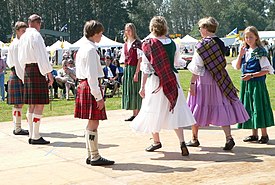
Back স্কটিছ দেশৰ নৃত্য Assamese Scottish Country Dance German Danse écossaise French Contra-danns Albannach Scots/Gaelic Ballo tradizionale scozzese Italian Scottish country dance NN Шотландские бальные танцы Russian
This article includes a list of general references, but it lacks sufficient corresponding inline citations. (January 2021) |

| Part of a series on the |
| Culture of Scotland |
|---|
 |
| People |
| Mythology and Folklore |
| Cuisine |
| Religion |
| Art |
| Literature |
Scottish country dance (SCD) is the distinctively Scottish form of country dance, itself a form of social dance involving groups of couples of dancers tracing progressive patterns. A dance consists of a sequence of figures. These dances are set to musical forms (Jigs, Reels and Strathspey Reels) which come from the Gaelic tradition of Highland Scotland, as do the steps used in performing the dances. Traditionally a figure corresponds to an eight-bar phrase of music.
Country dancing, which is arguably a type of folk dancing, first appears in the historical record in 17th-century England. Scottish country dancing as we know it today has its roots in an 18th-century fusion of (English) country dance formations with Highland music and footwork. It has become the national ballroom dance form of Scotland, partly because "Caledonian Country Dances" became popular in upper-class London society in the decades after the Jacobite rising of 1745.[1] As early as 1724 there was a published collection of Scottish dance tunes by John and William Neal "A collection of the Most celebrated Scotch Tunes".[2] .[3]
When it first became popular around the 18th century, it was as a shorter, quicker form of dance[citation needed] that was a light relief from the more courtly dances normally danced.[1] Derived from early British forms of country dancing, SCD is related to English country dancing, contra dancing, Cèilidh dancing, Old time dancing and Irish set dancing (although most people in Scotland use the terms 'cèilidh dancing' or 'country dancing' interchangeably, with 'country dancing' often being taught in schools and later used at 'cèilidh' events). This is due to the combination of some of these dance forms in early country dance forms[1] and later cross-over introduced by their overlapping influences via dancers and dance masters.
Scottish country dancing (a social form of dance with two or more couples of dancers) should not be confused with Scottish Highland dance (a solo form of dance). There is a certain amount of cross-over, in that there are Scottish country dances that include Highland elements as well as Highland-style performance dances which use formations otherwise seen in country dances, but these are relatively few when the two dance forms are considered each as a whole.
- ^ a b c "What are 'Playford' dances?". Retrieved 12 December 2011.
- ^ Lamb, William. "Mr". Bagpipe News. National Piping Centre. Retrieved 28 October 2022.
- ^ Gore, Charles (ed.). "About This Website". Scottish Music Index: The 18th & 19th Century Printed Collections. Retrieved 25 June 2023.
© MMXXIII Rich X Search. We shall prevail. All rights reserved. Rich X Search